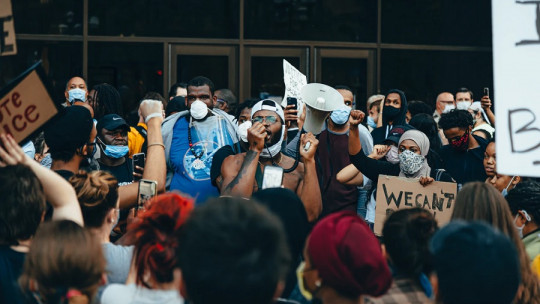
Our family, our group of friends, the town in which we were born, the political party in which we are active or the job we do are factors that influence our individual identity and, in turn, create a more extensive one: the collective identity.
In every human group, regardless of its size, there is a thought of seeing oneself as one, a group that has its defining traits and characteristics that make it different from others.
Next We will look further into the idea of collective identity what are the elements that can cause it to arise, why it is a somewhat controversial concept and how it could have arisen throughout the history of evolution.
What is collective identity?
To a greater or lesser extent, each person is part of a community. These communities can be of different sizes, levels and categories, and you can be in several simultaneously.
We are part of our family, our group of friends, town or city, region of birth, professional category and many more. The sense of belonging to each of these is part of our identity, an identity greatly influenced by social aspects.
Collective identity is defined as the feeling of belonging to a certain community It arises from the cultural and emotional ties that occur within the community, given that they are human environments in which a series of visions or ideals are shared and defended, which permeate the individual identity of each member of the group. Thus, since they all share, to a greater or lesser extent, the same traits and feel linked to them, they have a common feeling of relevance.
Collective identity involves the self-perception of a “we” (ingroup), a group of people who share a series of traits, in contrast to the “others” (outgroup), who have different traits. The importance given to one’s own traits and those of the outgroup is very subjective In addition to being subjective, the way in which certain symbols or features that delimit the group’s own identity are selected, such as race, nationality, language, religion, ideology…
Although each author differs regarding the exact definition of collective identity, the following four aspects can be highlighted that define what this idea is:
Elements of collective identity
The most notable element of any collective identity is the idea of culture It should be said that the term “culture” should not be understood only as a synonym for an ethnic group or geographical culture, such as French, Argentine, Jewish, Gypsy, Kurdish culture or any other.
The idea of culture must be understood as a set of sociocultural characteristics that define a certain group and that directly influences their collective identity.
We can find collective identity in professions, social movements, sports teams and many more social groups. For example, there is a collective identity among doctors, not only because they have studied medicine, but also because they share a series of typical experiences with their profession, in addition to how their work influences their personal life and their value as a person.
In sports teams and social movements the idea of collective identity is much more noticeable. In the case of sports teams, whether professional or amateur, the idea of belonging to the team is necessary, given that they are going to compete with other teams and it is necessary that there be a good dynamic within the team to win.
This same idea can be transferred to social movements, such as “Black Lives Matter”, the LGBT+ collective and the feminist. To ensure that their demands are met, it is necessary for all activists to coordinate to exert group pressure.
All these examples are proof that there are different types of elements that can make collective identity emerge. These elements can be several or simply one, varying depending on the type of community and the intensity of the degree of collective identity. Even between communities of the same type (professional, ethnic, ideological…) there are differences in what has defined and strengthened its collective identity, both in type of elements and in their quantity.
For example, the idea of being part of French culture does not depend only on speaking French, but also on being born there, defending the unity of the Republic and even sharing the same stereotypes towards other European countries. On the other hand, in the Jewish community the main element that defines it is processing Judaism, without the need to speak Hebrew, to have been born in Israel or to be in favor of the existence of a Jewish state.
A controversial concept
Although the expression “collective identity” is used very frequently, It is often used as a synonym for ethnic culture and seen as something that must be professed no matter what.
For example, there are many people with nationalist ideologies who defend that the individual identity of each person does not matter, what is important is the fact of having been born in a certain place and, therefore, they have the obligation to feel part of its culture. birth. Otherwise, he is seen as a traitor or a supporter of the extinction of that culture
Also in this misuse of the idea of collective identity, xenophobic visions are defended. There are many who consider that anyone born outside the place where they live are people who will never be part of their culture, since they do not have what it takes to do so. On many occasions that “what you have to have” involves aspects that cannot be chosen, such as race, mother tongue or culture of origin.
Not everyone has or wants to feel part of a collective identity, especially in its aspect related to geographical culture. There are those who prefer to feel like citizens of the world or cosmopolitans, not to be part of social movements or not to be part of a community.
Each person has a unique and different individual identity and in that identity there may be a characteristic of rejection of collective thought, sometimes very harmful as has happened on several occasions throughout history, as is the case of Nazism, terrorism and religious sects.
evolutionary function
The idea has been raised that collective identity has been a product of evolution in the human species. According to this theory, throughout evolutionary history hominids and the first Homo sapiens They have needed collective identity to guarantee the physical survival of the species.
Hominids are weak and slow primates, which makes them easy prey if they find themselves alone in front of a predator. That is why In the most critical moments of survival, a group response was necessary of hominids in the face of the threat, to disperse it or avoid as much damage as possible. This would explain why when someone close to us is threatened, we often prepare for the fight, ignoring the pain and fear, and even there are cases of self-sacrifice to ensure that others survive.
It has also been suggested that collective identity played an important role in creating the first human rites. Among these rituals would be dancing for hours, collectively entering states of ecstasy, singing in harmony or deworming the babies as a group. All these behaviors would be carried out synchronously promoting the idea that the group is one and allowing this synchronization to be put into practice when hunting or defending against predators or other human groups.








